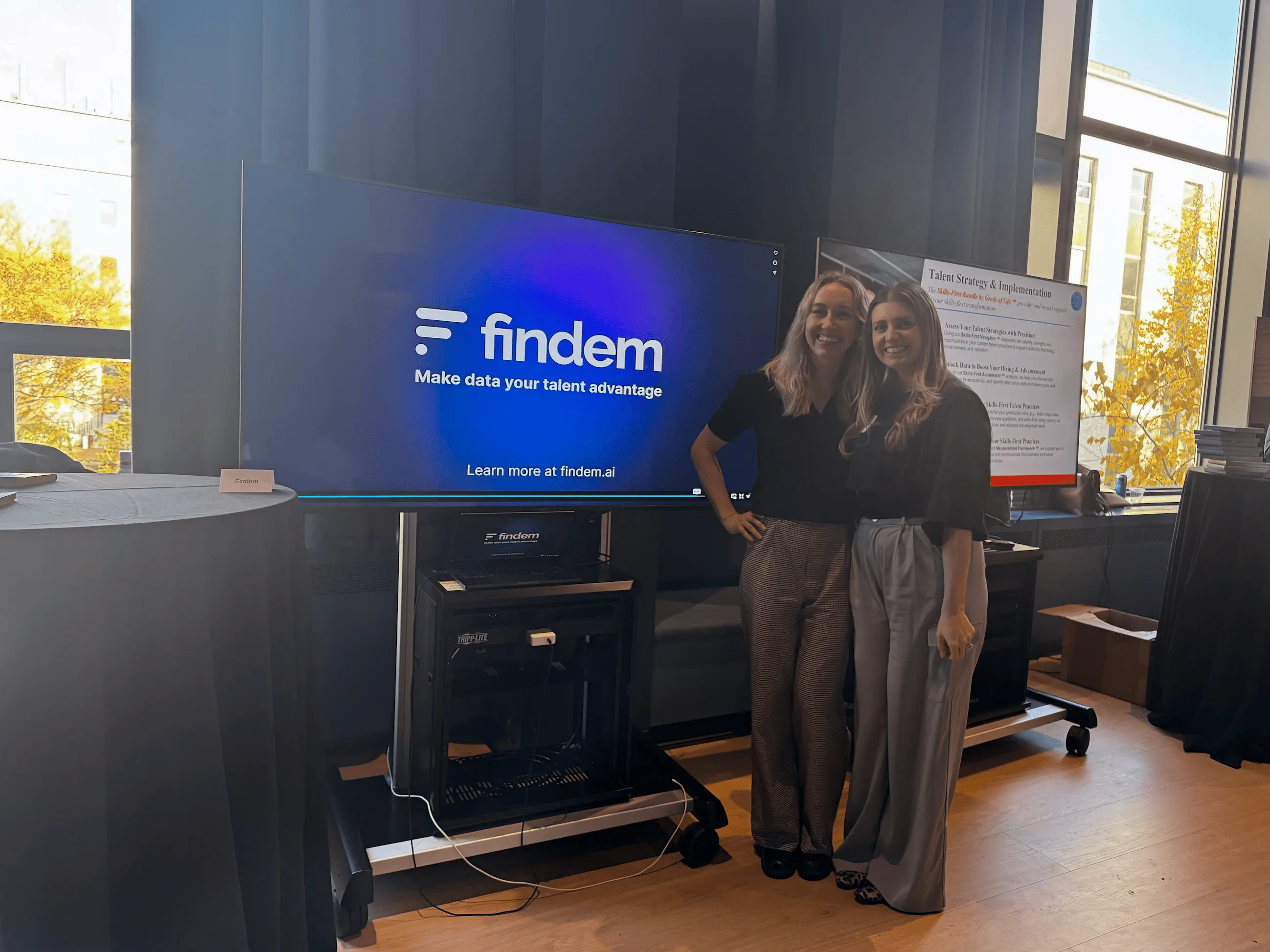.svg)
An AI maturity model for recruiting and talent leaders
.svg)

Artificial intelligence (AI) is transforming the recruiting landscape, changing how talent is sourced, assessed, and hired. However, the journey toward AI adoption is not uniform across organizations. Talent teams need to understand where they are in the AI recruiting maturity model to make informed decisions about the next steps in their AI journey.
According to GAI Insights, industries with the highest potential today include entertainment, software, professional services, financial services, and education due to the high level of digitization in their work and the percentage of cost base in this work.
A survey by Gartner found that “76% of HR leaders believe that if their organization does not adopt and implement AI solutions, such as generative AI, in the next 12-24 months, they will be lagging in organizational success compared to those that do.”
This blog will explore the 5 stages of AI maturity in recruiting and offer guidance on what talent leaders can do next to advance their AI capabilities.

Stage 1: Limited or no access to AI tools
In highly regulated industries like healthcare or financial services, or in companies with a particularly top-down culture related to technology adoption, there is no access to or very limited individual use of AI tools. This stage is characterized by a cautious approach to AI, often due to strict regulatory requirements or a conservative corporate culture that prioritizes risk management.
Challenges:
- Regulatory compliance concerns
- Lack of awareness and understanding of AI benefits
- Resistance to change from leadership
Next steps:
- Education and awareness: Begin by educating key stakeholders about the potential benefits of AI in recruiting. Highlight successful case studies from similar industries to build a compelling case for AI adoption.
- Pilot programs: Implement small-scale pilot programs to demonstrate the value of AI in specific recruiting tasks, such as resume screening or candidate matching. Ensure these pilots comply with regulatory requirements.
- Collaboration with legal and compliance teams: Work closely with legal and compliance teams to address concerns and develop guidelines for AI use in recruiting.
Stage 2: Individual use of AI without official sanction
In companies with a more open or experimental culture, employees might be using AI individually, but there's no official department or company sanction of it. This stage can create a free-for-all, posing risks to the company due to inconsistent and potentially unregulated AI use.
Challenges:
- Lack of standardized AI tools and processes
- Potential data security and privacy risks
- Inconsistent AI application across the organization
Next steps:
- Policy development: Develop a clear policy on AI use in recruiting. This policy should outline approved AI tools, usage guidelines, and data security measures. AI tools should help consolidate your tech stack, not just add to it.
- Centralized AI tools: Identify and implement a set of standardized AI tools for recruiting that are approved and supported by the organization. This helps ensure consistency and compliance.
- Training and support: Provide training to recruiters on the approved AI tools and best practices for their use. Establish a support system to assist with any technical or ethical issues that arise.
Stage 3: AI usage in existing productivity tools
Employees are using AI in available and existing technologies. This stage is expected to grow as more technologies incorporate generative AI from companies with productivity suites like Google, Microsoft, and Adobe to more specialized software for areas of the business like recruiting, executive search, and marketing. Organizations at this stage have begun to see the value of AI in enhancing existing recruiting processes.
Challenges:
- Integrating AI capabilities with existing systems
- Ensuring that AI tools align with recruiting goals and processes
- Managing the increased data generated by AI tools
- Creating a governance structure to define when and how to use AI
Next steps:
- Integration strategy: Develop a strategy for integrating AI capabilities with existing recruiting technologies. This may involve working with IT to ensure seamless integration and data flow.
- Performance metrics: Establish metrics to evaluate the performance of AI tools in recruiting. Monitor these metrics regularly to ensure that AI is delivering the expected benefits.
- Feedback loop: Create a feedback loop for recruiters to share their experiences with AI tools. Use this feedback to make continuous improvements and address any issues. Tackle the fear around job replacement with discussions about how AI changes the roles and responsibilities.
Stage 4: Integrating AI talent tools into the recruiting tech stack
Organizations at this stage are integrating new AI tools, particularly ones dedicated to specific job functions, into their tech stack. This approach allows for more targeted and effective use of AI in recruiting.
Challenges:
- Selecting the right AI tools for specific recruiting needs
- Ensuring that new AI tools integrate well with existing systems
- Training recruiters to use new AI tools effectively
Next steps:
- Tool evaluation: Carefully evaluate AI tools to determine which ones best meet your recruiting needs. Consider factors such as ease of integration, user experience, and support from the vendor.
- Implementation plan: Develop a detailed implementation plan for integrating new AI tools. This plan should include timelines, roles and responsibilities, and training requirements.
- Continuous improvement: Establish a process for continuously evaluating and improving the use of AI tools. This may involve regular reviews, user feedback, and updates to the tools as needed.
Stage 5: AI-first consideration for new recruiting tech
In this stage, companies require AI to be present as they evaluate new technology for their tech stack. If the technology doesn’t include AI, it won’t be considered. This approach ensures that AI is at the forefront of the organization’s recruiting strategy.
Challenges:
- Keeping up with rapid advancements in AI technology
- Ensuring that all new technologies align with the company’s AI strategy
- Balancing innovation with risk management
Next steps:
- AI-first policy: Formalize an AI-first policy for evaluating new recruiting technologies. This policy should outline the criteria for selecting new tools and ensure that AI capabilities are a priority.
- Innovation monitoring: Stay informed about the latest advancements in AI technology. This may involve attending industry conferences, participating in professional networks, and subscribing to AI research publications.
- Strategic partnerships: Establish partnerships with leading AI vendors and research institutions to stay ahead of the curve and gain early access to cutting-edge AI tools.
The importance of understanding your AI maturity stage
Understanding where your organization stands in the AI recruiting maturity model is crucial for several reasons:
- Strategic planning: Knowing your current stage allows you to develop a strategic plan for AI adoption that is realistic and achievable. It helps you set clear goals and milestones for progressing to the next stage in your recruiting strategy.
- Resource allocation: Different stages of AI maturity require different resources. By identifying your current stage, you can allocate resources more effectively, whether that means investing in training, new tools, or compliance measures.
- Risk management: Each stage comes with its own set of risks. Understanding your maturity level helps you identify and mitigate these risks more effectively. For example, companies in the early stages need to focus on compliance and data security, while those in later stages may need to manage the risks associated with rapid innovation.
- Competitive advantage: Organizations that successfully navigate the AI maturity model can gain a significant competitive advantage in the talent market. AI can streamline recruiting processes, improve candidate experiences, and enable more data-driven decision-making.
Unlock more recruiting potential with AI
The journey to AI maturity in recruiting is a multi-stage process that requires careful planning, resource allocation, and risk management. By understanding where your organization stands in the AI recruiting maturity model, you can make informed decisions about the next steps to take. Whether you are just beginning to explore AI or are already leveraging advanced AI tools, there is always room for growth and improvement.
Talent teams that embrace AI and navigate the maturity model effectively will be better positioned to attract, assess, and hire the best talent in an increasingly competitive market. The future of recruiting is AI-driven, and the time to start or continue your AI journey is now.
Download our latest guide to learn how to unlock your own potential as a talent leader and grow your career with the help of AI.










